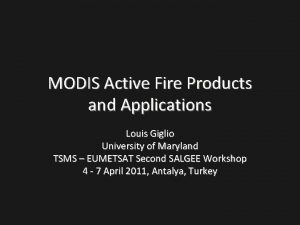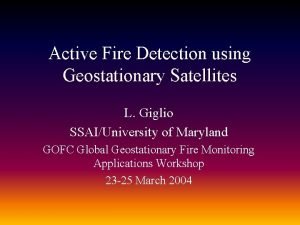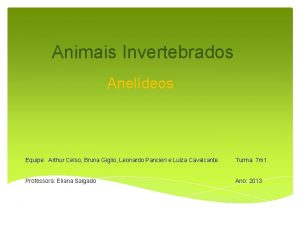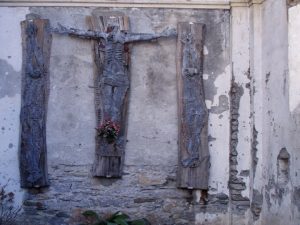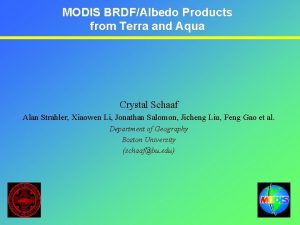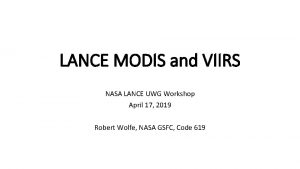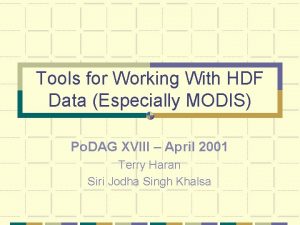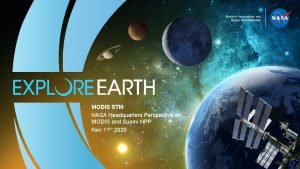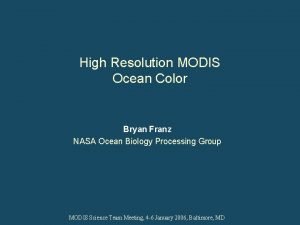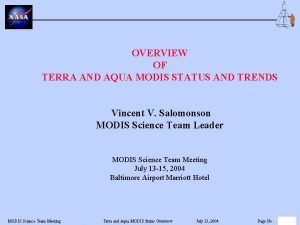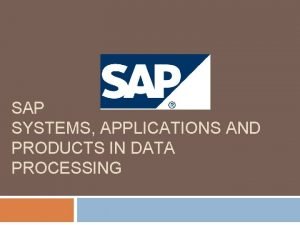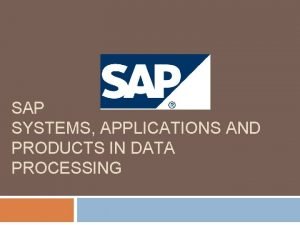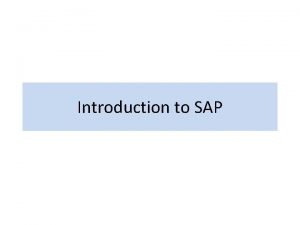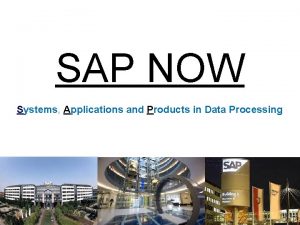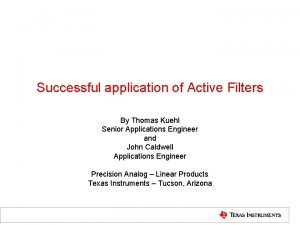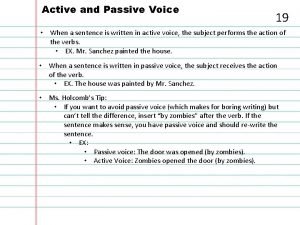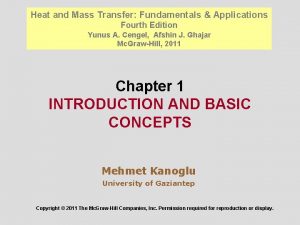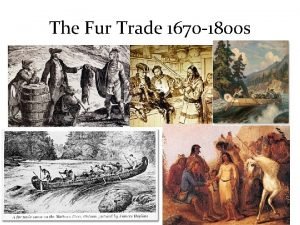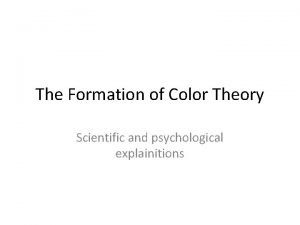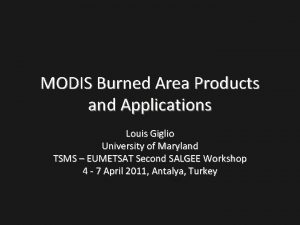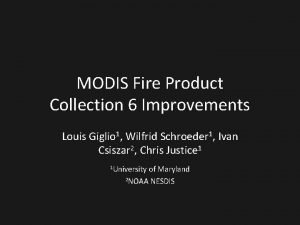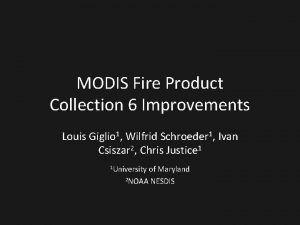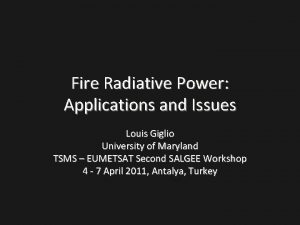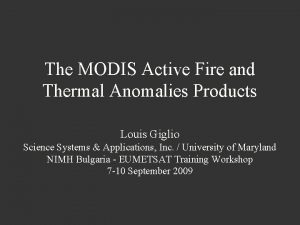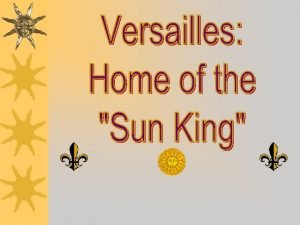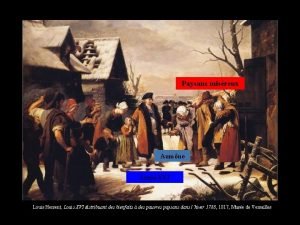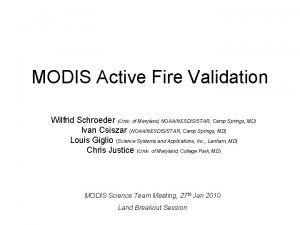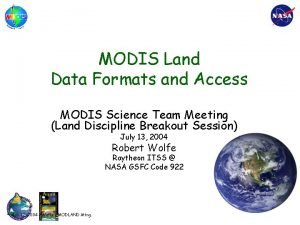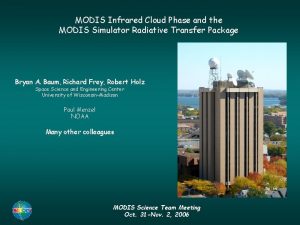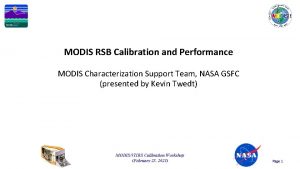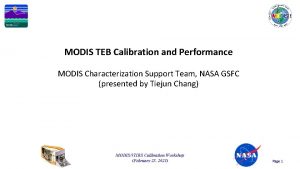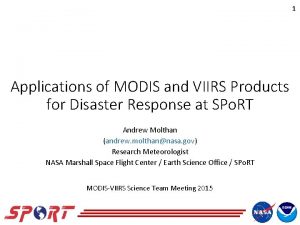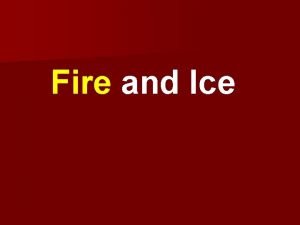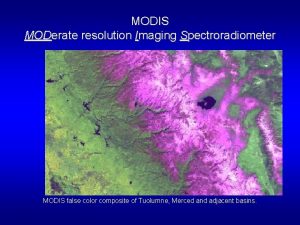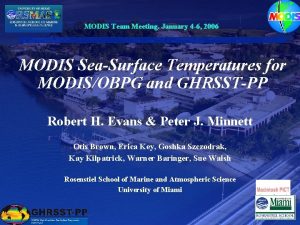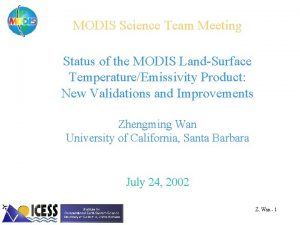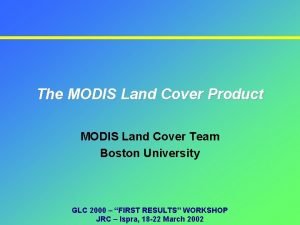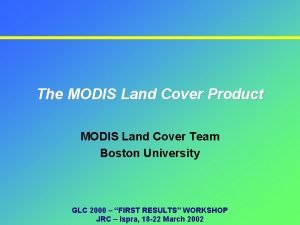MODIS Active Fire Products and Applications Louis Giglio























































- Slides: 55

MODIS Active Fire Products and Applications Louis Giglio University of Maryland TSMS – EUMETSAT Second SALGEE Workshop 4 - 7 April 2011, Antalya, Turkey

Satellite-Based Active Fire Products • Identify where fires are actively burning at time of satellite overpass (and implicitly when they are burning) • Possibly provide additional information about fires at time of satellite overpass – Intensity, average temperature, instantaneous size, rate of combustion, injection height, etc.

Southeast Australia, 10 Dec. 2006, 03: 45 UTC MODIS Rapid Response System

MODIS Instrument (1 of 2) • “Moderate Resolution Imaging Spectroradiometer” • On board AM-1 (“Terra”) and PM-1 (“Aqua”) polar orbiters – Terra 10: 30 & 22: 30 local overpass – Aqua 01: 30 & 13: 30 local overpass

MODIS Instrument (2 of 2) • 36 spectral bands covering 0. 4 to 14. 4 µm – Two 250 -m bands – Five 500 -m bands – Twenty nine 1 -km bands • Enable comprehensive daily evaluation of land, ocean, and atmosphere

MODIS Active-Fire Channels • Dedicated 1 km fire bands – Channel 21: 3. 96 µm, ≈ 500 K saturation – Channel 31: 11. 0 µm, ≈ 400 K saturation • Lower noise, lower quantization error, 1 -km multipurpose band – Channel 22: 3. 96 µm, ≈ 330 K saturation

Fire Detection Approach • Look for elevated signal at 4 m; use 11 m channel to help exclude warm, non-fire surfaces • Adaptive thresholds based on local statistics so algorithm can be applied globally • Use additional tests and channels to help reject false alarms – Small convective clouds, sun glint, heterogeneous surfaces, land cover/vegetation boundaries, coastline, desert and other hot/reflective surfaces, urban areas*

Products

Preliminaries • MODIS “Collection” – Reprocessing round or version – Currently at Collection 5 – Collection 6 reprocessing later this year • MODIS Tile – Global sinusoidal grid

MODIS Tiles

MODIS Fire Products (1 of 3) • Active Fire (Level 2 -- native swath) – – Fire mask QA layer Detailed information about each fire pixel MOD 14, MYD 14 • Active Fire (Level 3 -- tiled, sinusoidal grid) – – Cumulative fire mask Maximum fire radiative power (FRP) Daily and 8 -day summaries MOD 14 A 1, MYD 14 A 1, MOD 14 A 2, MYD 14 A 2

Example 8 -Day L 3 Fire Product Angola Fire Unknown Non-Fire Water Missing 2000 day 241 Tile h 19 v 10

MODIS Fire Products (2 of 3) • Climate Modeling Grid – Global, 0. 5° – Monthly, 8 -day – MOD 14 CMH, MYD 14 CMH MOD 14 C 8 H, MYD 14 C 8 H • Fire Locations – ASCII – Monthly – MCD 14 ML

MODIS Fire Products (3 of 3) • Rapid Response Products – Imagery (JPEG) – Near-real time active fire locations (ASCII)

Siberia, 22 May 2001

Distribution

https: //lpdaac. usgs. gov/lpdaac/get_data



CMG and Fire-Location Products fuoco. geog. umd. edu Login: fire Password: burnt cdmodis

Caveats

Product Caveats and Issues • • • Pre-November 2000 data quality Envelope of detectable fires False alarms Fire locations Active fire vs. burned area

Pre-November 2000 Data Quality • MWIR channels suffer from crosstalk, poor calibration, “dead” detectors • SWIR and TIR channels also affected (but to a lesser extent) • Obvious artifacts in many products

Early Terra MODIS Artifacts

Terra Band 21, Post-November 2000 Vietnam 2000311 03: 40

Factors Affecting Detection • • Fire size Fire temperature Biome Season Surface temperature Cloudiness Types of clouds • Position of sun • Viewing geometry • Characteristics of smoke • Instrument issues • Other

False Alarm Sources • • Small convective clouds Sun glint Land cover/vegetation boundaries Coastline Desert and other hot/reflective surfaces Heterogeneous surfaces Urban areas*

False Alarms Terra MODIS Shanghai 18 July 2004, 02: 45 UTC

Fire-Location Limitations • “Fire location”-only products omit useful information – ASCII (“text”) files – Lack spatial context • cloud cover, missing data, water – Sometimes inappropriate for research purposes (yet used anyway!)

Active Fire vs. Burned Area Data • In general they are not the same: – 1 km 2 “fire pixel” 1 km 2 area burning – 1 km 2 “fire pixel” 1 km 2 area burned


Validation

MODIS Active Fire Detection Validation

MODIS Active Fire Validation (1) • Primary method is to use coincident, high resolution ASTER imagery – “Advanced Spaceborne Thermal Emission and Reflection Radiometer” – Terra only (no Aqua ASTER) – 14 high resolution channels • 15 m, 30 m, 90 m • None ideal for observing fires

MODIS Active Fire Validation (2) • Fire mask using ASTER imagery – Sometimes degraded by frequent ASTER saturation • Fire radiative power retrieval using ASTER – Cannot use simple middle-infrared band approach used for MODIS with ASTER – Often degraded by frequent ASTER saturation • Simulated MODIS imagery • Independent burn scar maps – Usually not able to evaluate false alarm rate

MODIS Active Fire Detection Validation Post-Fire Burn Scar Maps Coincident 30 -m ASTER Imagery de Klerk (2008)

ASTER Fire Detection Approach • Use two reflective bands – One sensitive to emissive radiation from fires • SWIR band 8 (2. 3 m) – One insensitive to emissive radiation from fires • NIR band 3 N (0. 86 m) – Otherwise highly correlated and sensitive to reflective, non-fire radiation • Approach is reasonable for small ASTER pixels, but useless at coarser spatial resolution

Example Scene: Eastern Cambodia ASTER Bands 8 (2. 33 µm), 3 N (0. 82 µm), 1 (0. 56 µm) Active Fire Mask 12 km

ASTER Band 9 Grid delineates “edges” of 1 -km MODIS pixels. Southern Africa, 17 Aug. 2001

MODIS Active Fire Detection Validation via ASTER

Example Simulation Results • MODIS • Temperate deciduous rainforest • Night • 0° scan angle • Summer • No background fires

Applications and Results

Terra MODIS 2001 -2010 Monthly Active Fires

Terra MODIS Peak Fire Month Giglio et al. (2006)

Autocorrelation Giglio et al. (2006)

Aqua Fire Fraction STRONGER Giglio et al. (2006) WEAKER DIURNAL CYCLE STRONGER

Global Fire Emissions Database (GFED)

Mc. Carty et al. (2007)

Plume Heights Mazzoni et al. (2007)

Global Fire Regimes Chuviecoet al. (2008)

Collection 6

Collection 6 Algorithm Refinements • Reduce false alarms in problem areas • Processing extended to oceans and other large water bodies (to detect gas flaring) • Improved cloud mask • Improve detection confidence estimate • Improved land/sea mask* • Improved input data quality*

Collection 5

Collection 6

Additional Information • MODIS Fire and Thermal Anomalies – http: //modis-fire. umd. edu/ • MODIS Active Fire Product User’s Guide – http: //modis-fire. umd. edu/AF_usermanual. html • MODIS Land Rapid Response System – http: //rapidfire. sci. gsfc. nasa. gov/ • WIST (order MODIS land products) – https: //wist. echo. nasa. gov/~wist/api/imswelcome/
 Modis active fire product
Modis active fire product Vl louis vuitton
Vl louis vuitton Giglio
Giglio Alessandra giglio
Alessandra giglio Giglio
Giglio Bruna giglio
Bruna giglio Bruna giglio
Bruna giglio Makrocytos
Makrocytos Cindy giglio beaumont tx
Cindy giglio beaumont tx Donna del paradiso
Donna del paradiso Petalo al microscopio
Petalo al microscopio Modis competence center
Modis competence center Lance modis
Lance modis Modis
Modis Stm nasa
Stm nasa Modis
Modis Aqua terra modis
Aqua terra modis Modis bands
Modis bands Systems, applications, products in data processing
Systems, applications, products in data processing System application and products in data processing
System application and products in data processing Sap systems applications and products
Sap systems applications and products Sap now
Sap now Functional products examples
Functional products examples Pepsi products vs coke products
Pepsi products vs coke products Active high and active low
Active high and active low Active transport
Active transport Applications of active filters
Applications of active filters Reichstag fire who was the fire starter
Reichstag fire who was the fire starter Alarm
Alarm Uttar pradesh fire prevention & fire safety rules, 2005
Uttar pradesh fire prevention & fire safety rules, 2005 Ire fire fire rwi
Ire fire fire rwi Fight fire with fire definition
Fight fire with fire definition Thomas feeds his dog
Thomas feeds his dog Primary active transport vs secondary active transport
Primary active transport vs secondary active transport Lestat and louis relationship
Lestat and louis relationship Louis xiv and peter the great venn diagram
Louis xiv and peter the great venn diagram Louis xiv and peter the great
Louis xiv and peter the great Absolutism louis xiv
Absolutism louis xiv Core values slu
Core values slu Le vau et mansart
Le vau et mansart How did shang rulers consolidate and enforce their power?
How did shang rulers consolidate and enforce their power? Application of heat transfer
Application of heat transfer Image sets
Image sets Introducing and naming new products and brand extensions
Introducing and naming new products and brand extensions Introducing and naming new products and brand extensions
Introducing and naming new products and brand extensions Mbti mc kevin
Mbti mc kevin Robert louis stevenson victorian era
Robert louis stevenson victorian era Down on the roof so brown
Down on the roof so brown Chapter 21 section 2 the reign of louis xiv
Chapter 21 section 2 the reign of louis xiv 1670 fur trade
1670 fur trade Jacques louis david marie antoinette
Jacques louis david marie antoinette French revolution estates cartoon
French revolution estates cartoon Prang color wheel
Prang color wheel Foreign policy of louis philippe
Foreign policy of louis philippe Tfa st louis
Tfa st louis Jerry rev harris character analysis
Jerry rev harris character analysis
